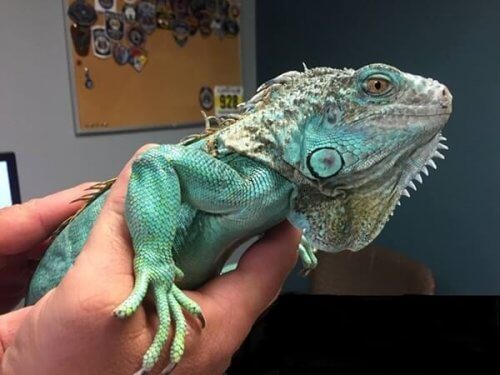Diseases in Pet Iguanas - The Most Common Ones


Written and verified by the lawyer Francisco María García
Pet iguanas are quite popular. However, these animals are prone to diseases, infections, burns, stress, and all sorts of ailments that can lead to irreparable damage. It’s currently all the rage to have reptiles as pets. And this is mainly because people are often attracted to the extravagant nature of their skin. However, there are some diseases in pet iguanas that you should be aware of.
Having this kind of pet requires preparation, care, and the development of a controlled ecosystem. This is because, at the end of the day, every ailment the animal may suffer will depend on external factors typical of their environment such as grooming, heat sources, etc.
But, in principle, you must know what iguana diseases there are, and the symptoms that can help you identify them.

Infectious diseases can be lethal in pet iguanas
First of all, viruses, parasites, and bacteria can do great harm to our pets. The combination of light, water, minerals, food, and waste is a breeding ground for the spread of all sorts of protozoa.
Amoebas and worms can also damage a reptile. Infections like salmonella can be lethal or at least cause considerable damage to the animal. Not only that, but they could also transmit it to humans.
So, the strength of the animal’s immune system, along with their level of stress are what usually make a difference. In the case of gastrointestinal infections, which are the most common, the warning symptoms are vomiting and diarrhea. Take the animal to the vet if you notice these signs.
Lack of calcium can harm iguanas
One of the characteristic problems of this species is due to their difficulties absorbing calcium from food. It originates in their metabolism and you can easily notice the consequences.
Another cause of this condition has to do with the lack of ultraviolet B light. You can see the symptoms of this disease in the animal’s hind legs. This is because they swell up and look a bit drier than normal.
There are a couple of alternatives as a solution: add calcium supplements to their food and provide them with plenty of sunlight and fluorescent light. This way you’ll avoid bone decay and subsequent fractures.

Diseases in pet iguanas – burns
As you’ve seen, light is essential for the proper development of this type of reptile, be it solar or artificial. However, you must be careful. This is because lighting sources and heat in the terrarium could burn the animal.
Therefore, light and heat sources should be out of the reach of these animals, ideally. The skin of burned iguanas usually turns black, gray, or a reddish color in the affected areas.
Of course, minor burns usually heal on their own. However, those of greater severity require medical attention and subsequent treatment, especially if they cause blisters in the animal.
Prolapse in reptiles
Prolapse is, in medical terms, the decay or fall of some internal organs. This clinical condition affects iguanas in the colon, oviduct, bladder, and even the hemipenes in its reproductive organ.
The problem is notorious for the internal organs that suddenly come out and one can see them from the outside. In this case, the correct thing to do is keep the protuberance as clean as possible and consult the vet.
You must keep in mind that the complications derived from this condition are infections. Generally, the organ prolapse is caused by parasites or pathogens and the condition can always worsen. You must quickly attend to this type of emergency in iguanas and lizards.
Broken toes are a common accident
Your iguana will break its toes and claws on several occasions. In general, accidents are the main reason for this type of injury. It happens when the animal walks on an uneven surface or their feet get caught between two rocks, etc.
The iguana’s own fear of getting stuck plays a crucial role in this kind of situation. The main thing here is to look at the depth and severity of the wound. In this sense, there are wounds that don’t cause pain when you press them.
But, the right thing to do if you can see an open wound with your naked eye is to take them to the vet. As you can see, almost all iguana diseases are treatable if diagnosed early, but only under specialized veterinary care.
Stress is one of the worst diseases in pet iguanas
This animal is an example of one in which psychological and external factors can wreak havoc at a biological level. The iguana will stress out if their ecosystem isn’t comfortable – they have real trouble adapting to it.
Unfortunately, stress is a gateway to all kinds of illnesses. Therefore, it’s essential to carefully plan their ecosystem and be aware of any strange behavior. The animal must be in harmony with its environment in order to avoid diseases.
Pet iguanas are quite popular. However, these animals are prone to diseases, infections, burns, stress, and all sorts of ailments that can lead to irreparable damage. It’s currently all the rage to have reptiles as pets. And this is mainly because people are often attracted to the extravagant nature of their skin. However, there are some diseases in pet iguanas that you should be aware of.
Having this kind of pet requires preparation, care, and the development of a controlled ecosystem. This is because, at the end of the day, every ailment the animal may suffer will depend on external factors typical of their environment such as grooming, heat sources, etc.
But, in principle, you must know what iguana diseases there are, and the symptoms that can help you identify them.

Infectious diseases can be lethal in pet iguanas
First of all, viruses, parasites, and bacteria can do great harm to our pets. The combination of light, water, minerals, food, and waste is a breeding ground for the spread of all sorts of protozoa.
Amoebas and worms can also damage a reptile. Infections like salmonella can be lethal or at least cause considerable damage to the animal. Not only that, but they could also transmit it to humans.
So, the strength of the animal’s immune system, along with their level of stress are what usually make a difference. In the case of gastrointestinal infections, which are the most common, the warning symptoms are vomiting and diarrhea. Take the animal to the vet if you notice these signs.
Lack of calcium can harm iguanas
One of the characteristic problems of this species is due to their difficulties absorbing calcium from food. It originates in their metabolism and you can easily notice the consequences.
Another cause of this condition has to do with the lack of ultraviolet B light. You can see the symptoms of this disease in the animal’s hind legs. This is because they swell up and look a bit drier than normal.
There are a couple of alternatives as a solution: add calcium supplements to their food and provide them with plenty of sunlight and fluorescent light. This way you’ll avoid bone decay and subsequent fractures.

Diseases in pet iguanas – burns
As you’ve seen, light is essential for the proper development of this type of reptile, be it solar or artificial. However, you must be careful. This is because lighting sources and heat in the terrarium could burn the animal.
Therefore, light and heat sources should be out of the reach of these animals, ideally. The skin of burned iguanas usually turns black, gray, or a reddish color in the affected areas.
Of course, minor burns usually heal on their own. However, those of greater severity require medical attention and subsequent treatment, especially if they cause blisters in the animal.
Prolapse in reptiles
Prolapse is, in medical terms, the decay or fall of some internal organs. This clinical condition affects iguanas in the colon, oviduct, bladder, and even the hemipenes in its reproductive organ.
The problem is notorious for the internal organs that suddenly come out and one can see them from the outside. In this case, the correct thing to do is keep the protuberance as clean as possible and consult the vet.
You must keep in mind that the complications derived from this condition are infections. Generally, the organ prolapse is caused by parasites or pathogens and the condition can always worsen. You must quickly attend to this type of emergency in iguanas and lizards.
Broken toes are a common accident
Your iguana will break its toes and claws on several occasions. In general, accidents are the main reason for this type of injury. It happens when the animal walks on an uneven surface or their feet get caught between two rocks, etc.
The iguana’s own fear of getting stuck plays a crucial role in this kind of situation. The main thing here is to look at the depth and severity of the wound. In this sense, there are wounds that don’t cause pain when you press them.
But, the right thing to do if you can see an open wound with your naked eye is to take them to the vet. As you can see, almost all iguana diseases are treatable if diagnosed early, but only under specialized veterinary care.
Stress is one of the worst diseases in pet iguanas
This animal is an example of one in which psychological and external factors can wreak havoc at a biological level. The iguana will stress out if their ecosystem isn’t comfortable – they have real trouble adapting to it.
Unfortunately, stress is a gateway to all kinds of illnesses. Therefore, it’s essential to carefully plan their ecosystem and be aware of any strange behavior. The animal must be in harmony with its environment in order to avoid diseases.
This text is provided for informational purposes only and does not replace consultation with a professional. If in doubt, consult your specialist.








